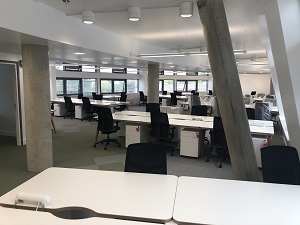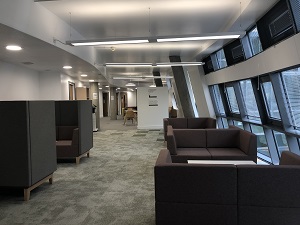Leverhulme Centre moves into innovative new research space
The Leverhulme Centre for Anthropocene Biodiversity (LCAB) is delighted to announce that we've moved into a newly refurbished space in the Berrick Saul building on Campus West at the University of York.
.jpg)
Our new space is purpose designed to facilitate collaboration between researchers from across disciplines and departments in an innovative, interactive environment.
The investment in the space by the University represents its commitment to supporting LCAB as a world-leading, interdisciplinary research centre which is prepared to tackle fundamental questions about biodiversity that others are shying away from, such as how human activity can have positive as well as negative impacts. By bringing together a team of researchers which spans the Sciences, Social Sciences and Arts and Humanities, the Centre will develop an holistic understanding of empirical data, theory and societal responses to the challenges of biodiversity change in the Anthropocene drawing on a range of perspectives.

Chris Thomas, Centre Director said: “It's wonderful to have a space where people from different backgrounds and perspectives can meet up to discuss the impacts that humans have already had on the biological world and vice versa and to contemplate different possible futures. LCAB aspires to stimulate a profound shift in environmental thinking. Our interdisciplinary approach to understanding, interpreting and responding to the challenges of the Anthropocene - both gains and losses - will help identify opportunities to increase the future sustainability of our planet.
“Delivering a space which encourages collaboration between researchers from a diversity of disciplines in both informal and formal settings is key to the success of the Centre. The Berrick Saul refurbishment provides a place which offers a range of working environments and maximises the potential for innovative new research to develop and flourish.”
Having identified a suitable area on campus, the University worked with York-based Mass Architecture and Vine House Construction to create a space which not only provides a suitable home for LCAB for the lifetime of the Centre but represents an investment in the building, future proofing it for many years to come.

Charlotte Harrison, founding partner of Mass Architecture, said: “The original concept was ‘a framework for growth’, a literal and symbolic interpretation of the Centre’s objectives. A gridded framework was introduced to perform on a multi-functional level; as a zoning device, space for storage and to add aesthetic interest and variation across the floorplate. Overall, the centre is divided into three zones offering different noise levels, ways to interact and types of activity.”
The space delivers individual offices, open-plan informal seating areas for collective discussion, quiet desks for individual research and meeting spaces with built in technology to allow for collaboration with the Centre’s national and international partners based at St Andrews (Scotland), University of Sherbrooke (Canada) and the Australian National University (Australia). We look forward to welcoming researchers and practitioners from around the world to join our visitor programme and enjoy working with us in our new interactive space, as soon as Covid-19 permits.